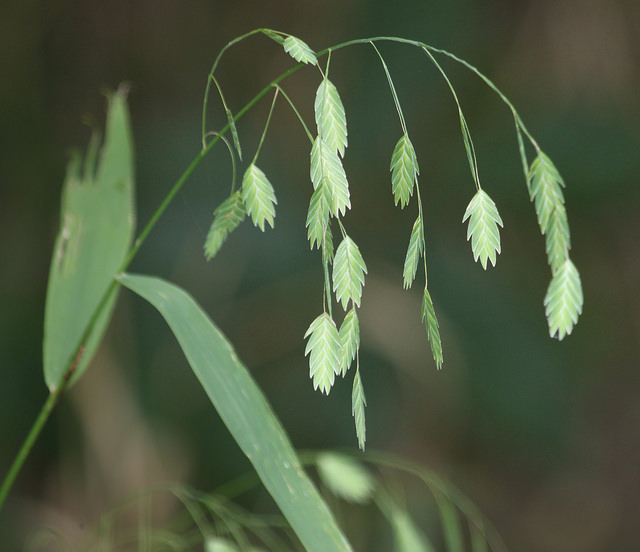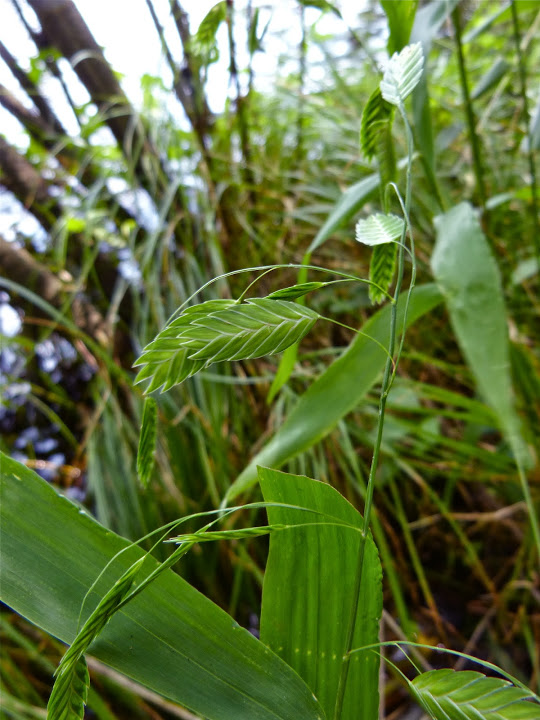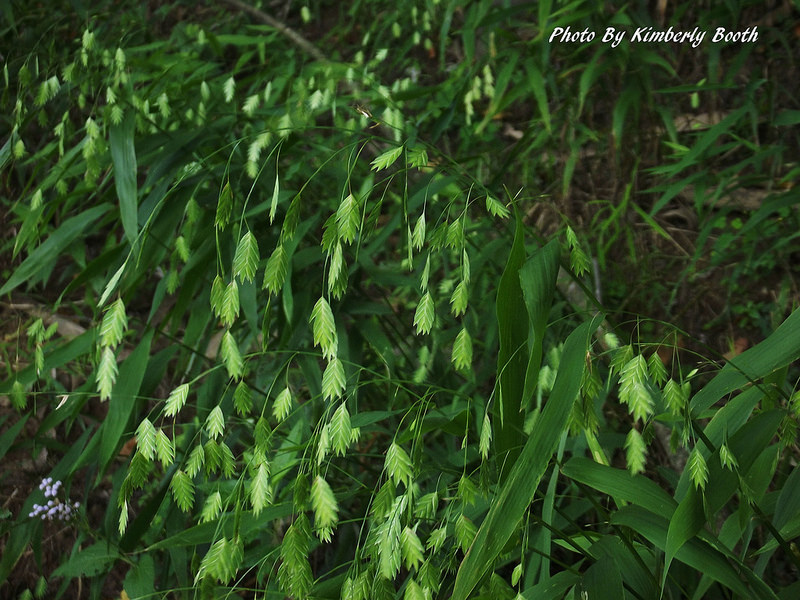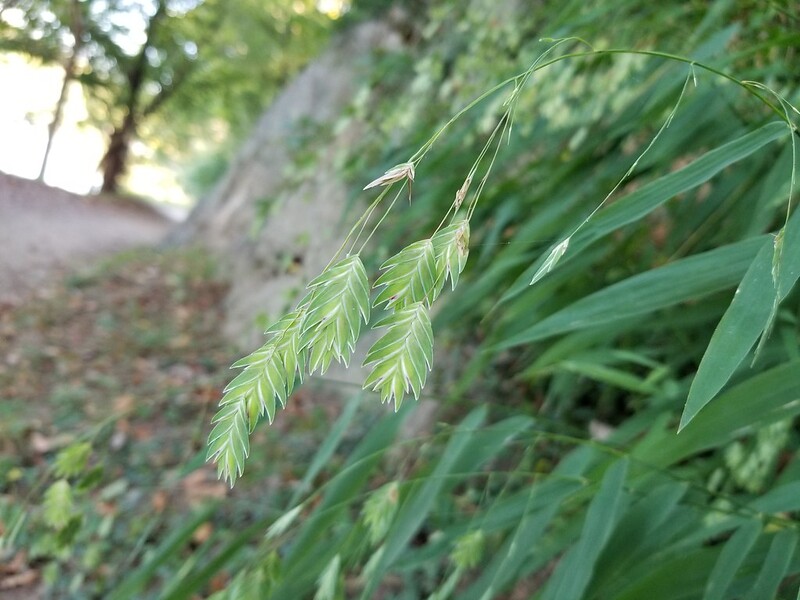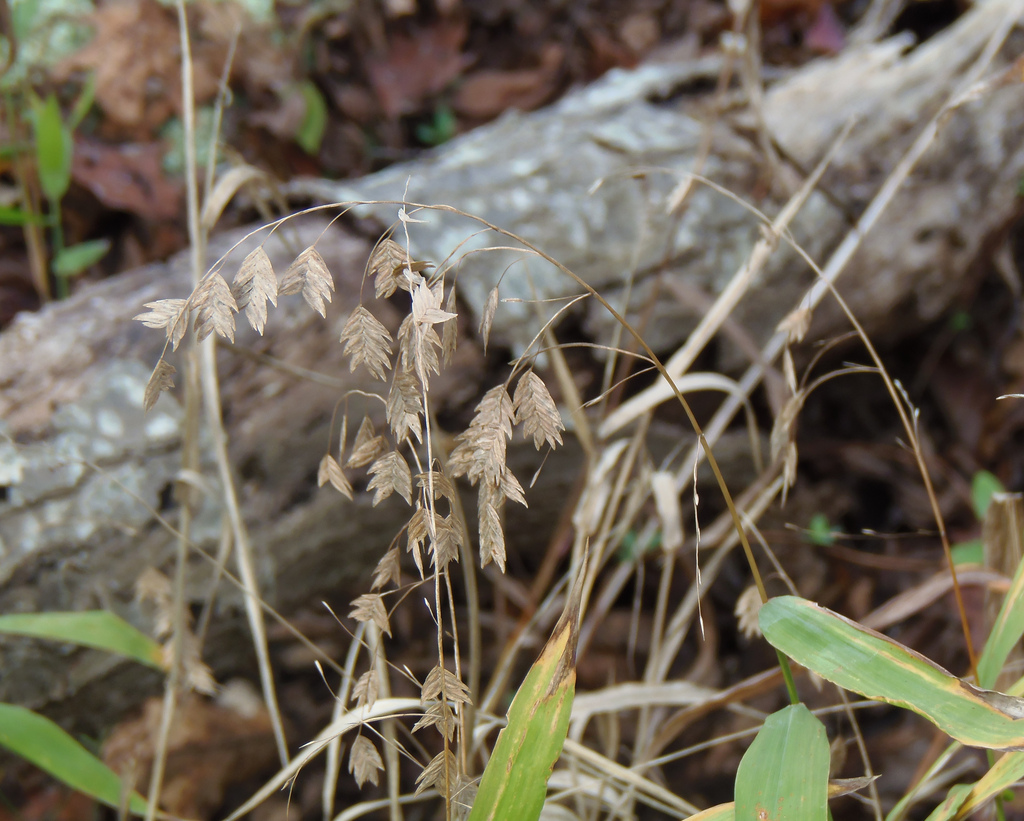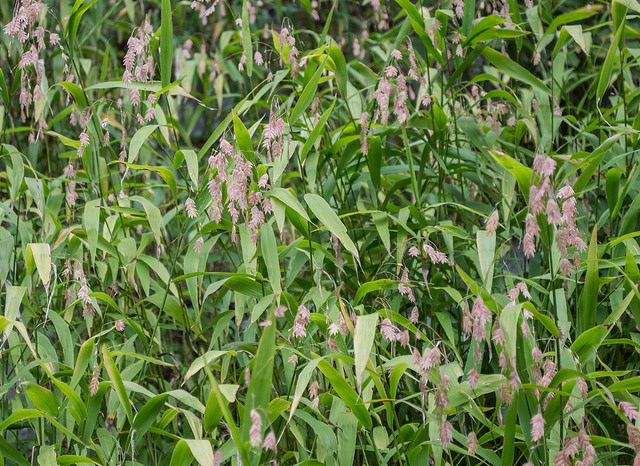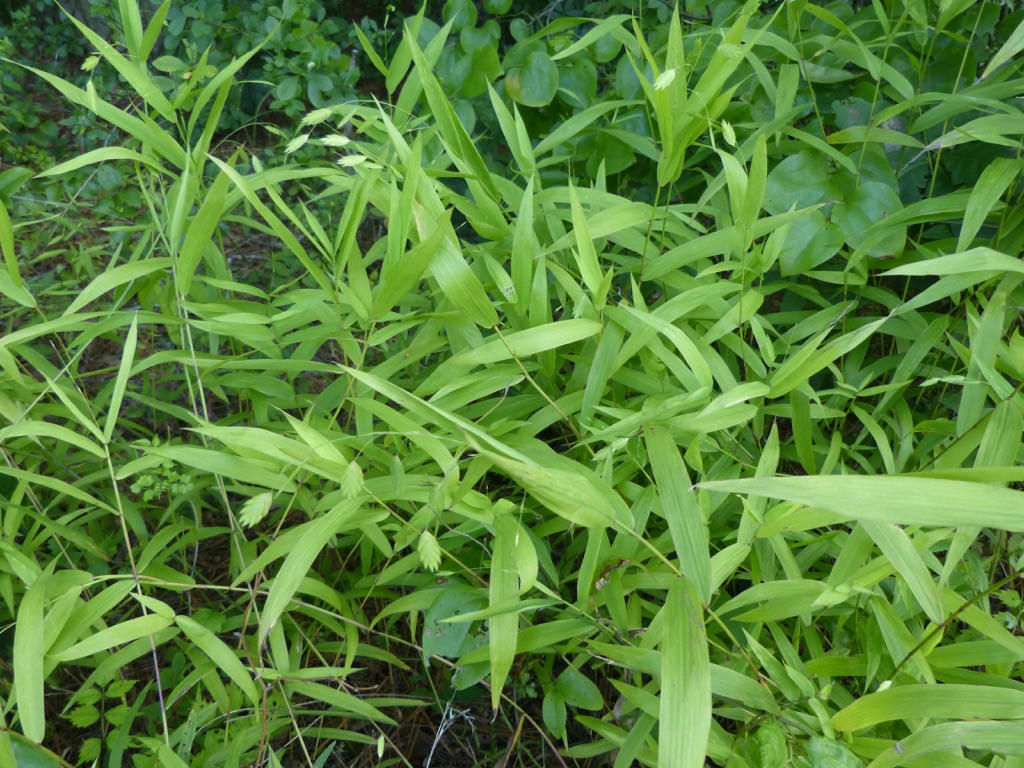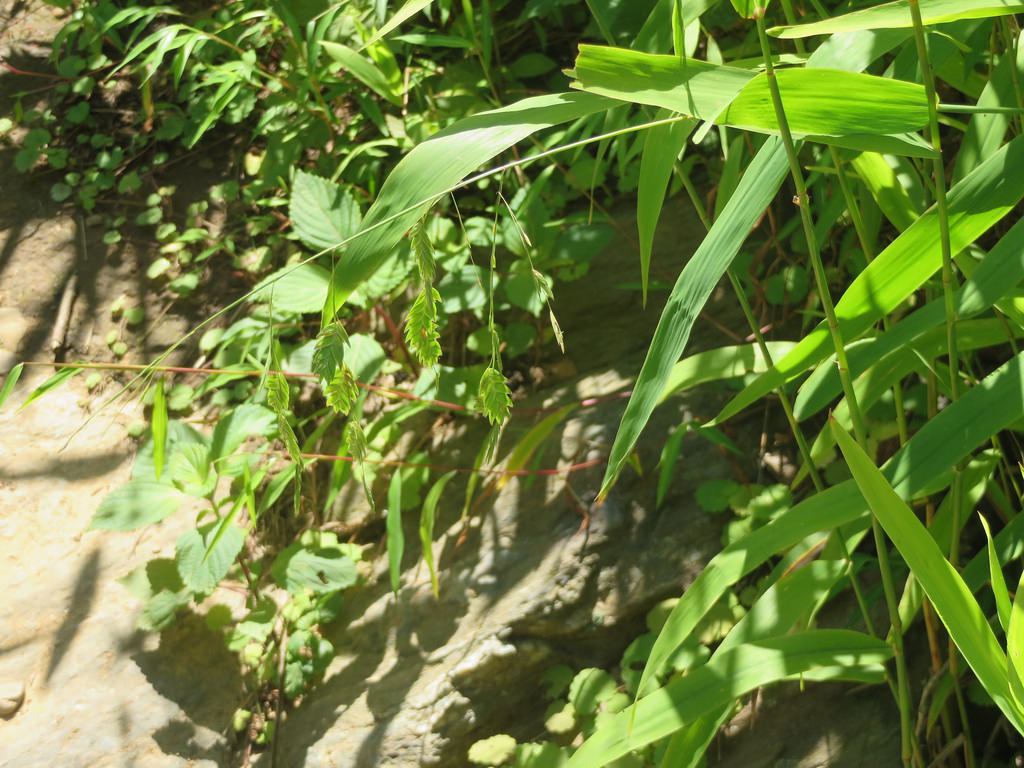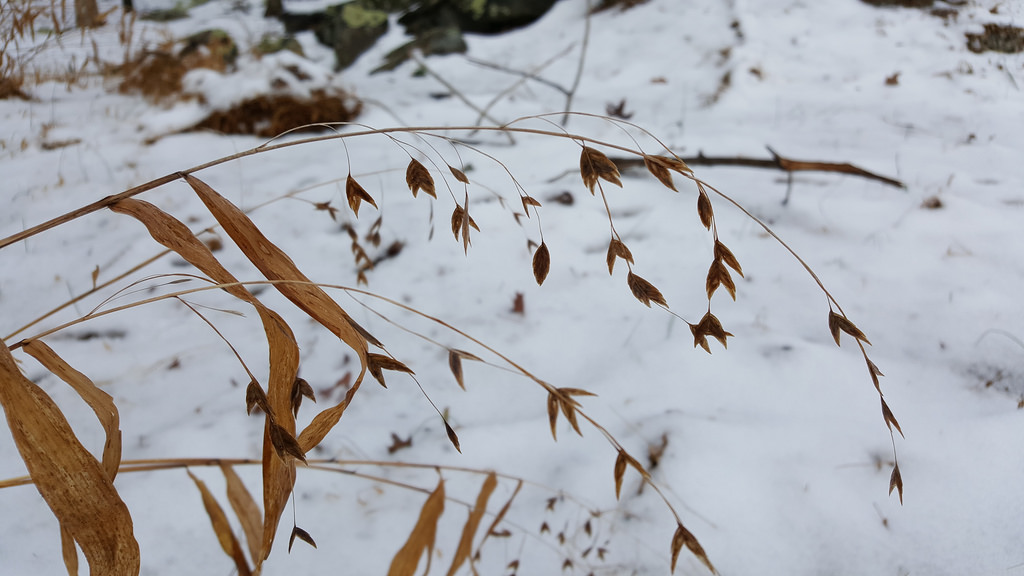Map Snapshot























203 Records
Status
A perennial, fairly tall grass that grows in colonies in moist woods and along stream banks.
Description
Produces conspicuous nodding flowers through the summer and fall.
Where To Find
Common along the Potomac drainage (Terrell & Peterson, 2009).
Relationships
Indian Woodoats is a host plant for Common Roadside Skipper and Pepper and Salt Skipper.
Seasonality Snapshot
Source: Wikipedia
| Chasmanthium latifolium | |
|---|---|

| |
| Scientific classification | |
| Kingdom: | Plantae |
| Clade: | Tracheophytes |
| Clade: | Angiosperms |
| Clade: | Monocots |
| Clade: | Commelinids |
| Order: | Poales |
| Family: | Poaceae |
| Subfamily: | Panicoideae |
| Genus: | Chasmanthium |
| Species: | C. latifolium
|
| Binomial name | |
| Chasmanthium latifolium (Michx.) Yates
| |
Chasmanthium latifolium, known as fish-on-a-fishing-pole, northern wood-oats, inland sea oats, northern sea oats, and river oats is a species of grass native to the central and eastern United States, Manitoba, and northeastern Mexico; it grows as far north as Pennsylvania and Michigan,[2] where it is a threatened species.[3] The species was previously classified as Uniola latifolia (André Michaux).
Description
[edit]Chasmanthium latifolium is a cool-season, rhizomatous, perennial grass with culms about 1 m [3 feet] tall.[4] The inflorescence is an open, nodding panicle of laterally compressed (flattened) spikelets. The plant typically grows in wooded areas and riparian zones.[5]
Distribution
[edit]Chasmanthium latifolium is native to the lower forty-eight states.[6]
In the arid west Chasmanthium latifolium is equally likely to be found in wetlands and non-wetland areas. In the Atlantic and Gulf Coastal Plain Chasmanthium latifolium is equally likely to be found in wetlands and non-wetland areas. In the Western Mountains, Valleys, and Coast Chasmanthium latifolium is equally likely to be found in wetlands and non-wetland areas. In the Eastern Mountains and Piedmont Chasmanthium latifolium usually occurs in non-wetlands. In the Great Plains Chasmanthium latifolium usually occurs in non-wetlands. In the Midwest Chasmanthium latifolium usually occurs in wetlands. In the Northcentral and Northeast Chasmanthium latifolium usually occurs in wetlands. [7]
In Mississippi Chasmanthium latifolium is a common species found in the river bank community, which is found between the start of the water and the high water mark. Here the substrate is frequently disturbed and is made of sand, acidic soils, and rocky outcrops. [8]
Ecology
[edit]Chasmanthium latifolium is wind-pollinated like most of the Poaceae family. Limited pollination range has significantly reduced gene transfer along the range edge, thus lowering genetic diversity. This low genetic diversity and lack of gene transfer between populations of Chasmanthium latifolium along the range edge makes Chasmanthium latifolium more susceptible to climate change and disease.[9]
The optimal growing temperature for Chasmanthium latifolium is 25 C. At 13 C Chasmanthium latifolium can no longer grow.[10]
Chasmanthium latifolium is a salt-tolerant species. The shoot growth of Chasmanthium latifolium is not affected by salinity levels up to an electrical conductivity of 10.0 dS m-¹. Root growth increased at salinity levels of electrical conductivity of 5.0 dS m-¹ and greater. [11]
Chasmanthium latifolium is a shade-tolerant plant[12][13][14] and maintains a positive carbon uptake in dense canopies. Chasmanthium latifolium continues carbon fixation at levels 10 times lower than other C4 grasses and light levels 80% less than their saturation point. [15]
It is a larval host plant for the Northern Pearly-Eye, and its seeds are food for birds and mammals. It is also eaten by the caterpillars of the pepper and salt skipper, Bell's roadside skipper,[16] and bronzed roadside skipper butterflies.
Chasmanthium latifolium is a fire-adapted grass best adapted to a low frequency of fire. Chasmanthium latifolium increases in abundance after one fire but decreases in abundance with repeated burning. [17]
Gardens
[edit]
It is used in landscaping in North America, where it is noted as a native grass that thrives in partial shade; the plant is recommended for USDA hardiness zones 3–9 in acidic sands, loams, and clays.[18][19]Chasmanthium latifolium blooms in the late summer to early fall between the months of August and September.[20] Chasmanthium latifolium is recommended southeastern rain gardens where intermittent flooding may be present.[21] Chasmanthium latifolium can be slow to emerge and take at least one year to establish. Once established, C. latifolium can have a dry matter yield of up to 6,019 pounds per acre.[22]
Etymology
[edit]The genus name, Chasmanthium, has Greek origins and can be broken down into two parts. Chasme means "gaping" and anthemum means flower.[23] The specific epithet can be translated to "broad-leaved"[23]
Threats
[edit]Chasmanthium latifolium is negatively impacted by invasive species like Lespedeza cuneata. Chasmanthium latifolium is at risk due to overuse of herbicides like glyphosate.[24] Chasmanthium latifolium is also affected by applications of topramezone 0.05 kg a.i./ha or greater.[25]
Uses
[edit]Chasmanthium latifolium has historically been used by the Cocopah Nation as a food source. The Cocopah Nation would harvest, dry, and grind the seed heads and then mix them with water to make a rudimentary dough.[26]
Chasmanthium latifolium is used on green roofs in Korea. Chasmanthium latifolium best performs on flat roofs.[27]
Chasmanthium latifolium is planted as a perennial cool-season grass on old logging trails and landings to prevent erosion and provide wildlife habitat. [28]
References
[edit]- ^ "NatureServe Explorer 2.0". explorer.natureserve.org.
- ^ "Plants of the World Online | Kew Science". Plants of the World Online. Retrieved 2023-10-09.
- ^ "Chasmanthium latifolium (Indian Woodoats)". Global Biodiversity Information Facility. Retrieved 2010-07-08.
- ^ Navarrete-Tindall, Nadia (Summer 2010). "Native Cool-Season Grasses in Missouri". Missouri Prairie Journal. 31 (2): 20–25.
- ^ "PLANTS Profile for Chasmanthium latifolium (Indian woodoats)". PLANTS database. United States Department of Agriculture. Retrieved 2010-07-08.
- ^ "USDA Plants Database". plants.usda.gov. Retrieved 2024-10-24.
- ^ "USDA Plants Database". plants.usda.gov. Retrieved 2024-10-24.
- ^ Majure, Lucas C. “THE VASCULAR FLORA OF THE CHUNKY RIVER (MISSISSIPPI).” Journal of the Botanical Research Institute of Texas, vol. 1, no. 2, 2007, pp. 1179–202. JSTOR, http://www.jstor.org/stable/41971547. Accessed 25 Oct. 2024.
- ^ Hayes, Jonathan D., "Genetic Diversity & Connectivity of Chasmanthium latifolium (Poaceae) in Pennsylvania & the Effect on Conservation Status of a Rare Species" (2021). Honors Theses. 577. https://digitalcommons.bucknell.edu/honors_theses/577
- ^ Harvey, Michael P., and Mark H. Brand. "Growth and macronutrient accumulation of Chasmanthium latifolium (Michx.) Yates and Hakonechloa macra makino'Aureola'in response to temperature." HortScience 37.5 (2002): 765-767.
- ^ McKenney, C.B.; Mahato, T.R.; Schuch, U.K. (March 2016). "Salinity tolerance of ornamental grasses adapted to semi-arid environments". Acta Horticulturae (1112): 95–100. doi:10.17660/ActaHortic.2016.1112.13. ISSN 0567-7572.
- ^ Norcini, Jeffrey G., Mack Thetford, and James H. Aldrich. "Evaluation of grasses native to Florida under low input conditions." Southern Nursery Assn. Res. Conf. Proc. 46. 2001.
- ^ Wilson, Carl Richard, and S. Brown. Ornamental grasses. Colorado State University Cooperative Extension, 1999.
- ^ Cole, James T.; Cole, Janet C. (2000-03-01). "Ornamental Grass Growth Response to Three Shade Intensities". Journal of Environmental Horticulture. 18 (1): 18–22. doi:10.24266/0738-2898-18.1.18. ISSN 0738-2898.
- ^ Van Auken, O.W. (2022-01-01). "PHOTOSYNTHESIS OF INDIAN WOODOATS IN CENTRAL TEXAS WOODLANDS". The Texas Journal of Science. 74 (1). doi:10.32011/txjsci_74_1_Article1. ISSN 0040-4403.
- ^ Bess, James, and O. T. I. S. Enterprises. "Conservation Assessment for Bell's Roadside Skipper (Amblyscirtes belli Freeman)" (2005).
- ^ Alice Long Heikens, et al. “Short-Term Response of Chert and Shale Barrens Vegetation to Fire in Southwestern Illinois.” Castanea, vol. 59, no. 3, 1994, pp. 274–85. JSTOR, http://www.jstor.org/stable/4033698. Accessed 25 Oct. 2024.
- ^ "Northern Sea Oats - Ornamental Grasses - University of Illinois Extension". University of Illinois.
- ^ "NPIN: Chasmanthium latifolium (inland sea oats)". Native Plant Information Network. University of Texas. Retrieved 2010-07-08.
- ^ "Chasmanthium latifolium - Plant Finder". www.missouribotanicalgarden.org. Retrieved 2024-10-24.
- ^ Morash, Jennifer Dawn. Flooding tolerance of six native landscape plants for use in southeastern rain gardens. MS thesis. Auburn University, 2016.
- ^ Brakie, Melinda. "Adaptation of Perennial Native Cool Season Grasses in East Texas."
- ^ a b "Chasmanthium latifolium - Plant Finder". www.missouribotanicalgarden.org. Retrieved 2024-10-24.
- ^ Matthew S. Hodges and Carol Goodwillie "Investigating the Role of Soil Legacy Effects in the Management of Lespedeza cuneata, an Invasive Legume," Natural Areas Journal 43(2), 124-134, (19 April 2023). https://doi.org/10.3375/0885-8608-43.2.124
- ^ Marble, S. Christopher, Matthew T. Elmore, and James T. Brosnan. "Tolerance of Native and Ornamental Grasses to Over-the-top Applications of Topramezone Herbicide". HortScience horts 53.6 (2018): 842-849. < https://doi.org/10.21273/HORTSCI12989-18>. Web. 25 Oct. 2024.
- ^ Schnelle, Michael A. "Selective native plants of Oklahoma and nearby states that can be a nuisance to occasionally invasive." HortTechnology 31.4 (2021): 343-353.
- ^ 장, 하경; 한, 승원; 김, 재순; 정, 명일 (February 2014). "Characteristics of Coverage Ratio and Surface Temperature of Plants Planting on the Sloped Artificial Ground". Journal of Korean Society for People, Plants and Environment. 17 (1): 29–36. doi:10.11628/ksppe.2014.17.1.029. ISSN 1226-9778.
- ^ Brakie, Melinda. "Adaptation of Perennial Native Cool Season Grasses in East Texas."
